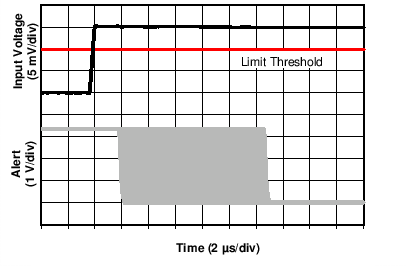ZHCSEX8B December 2015 – December 2021 INA300-Q1
PRODUCTION DATA
- 1 特性
- 2 应用
- 3 说明
- 4 Revision History
- 5 Pin Configuration and Functions
- 6 Specifications
-
7 Detailed Description
- 7.1 Overview
- 7.2 Functional Block Diagram
- 7.3 Feature Description
- 7.4 Device Functional Modes
- 8 Application and Implementation
- 9 Power Supply Recommendations
- 10Layout
- 11Device and Documentation Support
- 12Mechanical, Packaging, and Orderable Information
8.2.1.3 Application Curve
Figure 8-2 shows the alert response transitioning from a high to a low state following the input signal exceeding the limit threshold voltage. The time required for the output to respond varies as a result of when the input signal crosses the threshold limit voltage relative to where in the continuous running internal 10-µs comparison window the overrange condition occurs. In Figure 8-2, the output response varies from roughly 2 µs to approximately
12 µs when the input exceeds the threshold level. This variance is a result of where in the 10-µs comparison window the overrange event occurs. If the overrange event occurs late in the 10-µs comparison window and is large enough to average the entire window measurement up above the threshold level, the alert appears to respond very quickly. If the alert occurs late in the 10-µs comparison window and is not large enough to average the entire window measurement up above the threshold level, the alert does not appear until the next 10-µs comparison window completes, assuming the input signal remains above the threshold for the entire duration.
 Figure 8-2 Alert Response
Figure 8-2 Alert Response